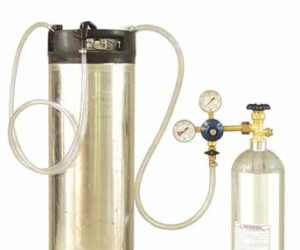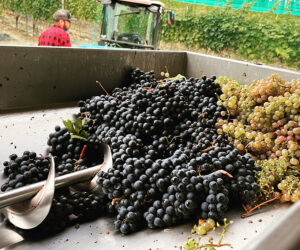The first rule of working with red hybrids is to forget everything you do for vinifera.”
I admit to using that line as an attention getter, but in no way does that imply that hybrid wines are inherently inferior to vinifera. Modern winemaking hybrids have come a long way in the last two decades and are capable of making some first-rate wines.
For the purposes of this article, hybrid wine grape species are defined as the vines resulting from the cross-pollination of European Vitis vinifera with one or more North American indigenous grape vine species. I have had the opportunity to make wines from cold region red hybrids grown in the Ontario and Quebec Canadian provinces such as Frontenac Noir, Baco Noir, Marquette, and from fungal-resistant British Columbia-grown Marechal Foch, Cabernet Libre, Regent, and Cabernet Foch. I have also had the opportunity to speak with many other winemakers working with a wide variety of hybrids. While there is no “one size fits all” winemaking tip for all varieties, making hybrids alongside vinifera highlights some general differences . . . and challenges.
The first thing I would say to any winemaker new to hybrid winemaking is that it can be extremely liberating from a creative expression point of view. There are no “Old World” or “Napa-inspired” models to limit your creativity, and the differences in working with them can really make your skills shine as a winemaker. This is something that should be embraced and celebrated as you will never be accused of trying to make an ersatz Bordeaux, pale imitation of Tuscany, or faux Mosel. Making the best wine you can from these grapes is your only goal.
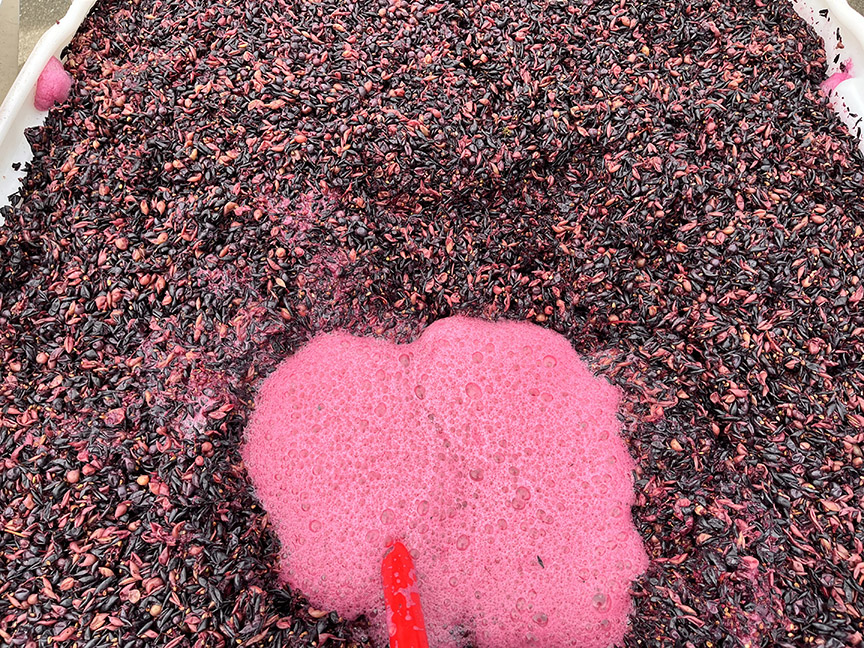
Why Hybrids?
Hybrid wine grapes have been bred over the years to grow in climates where vinifera wine grapes struggle. These may include locations where mean winter temperatures hit below -4 °F (-20 °C) or are too hot and humid, for traditional vinifera, or where resistance to local plant diseases such as Pierce’s disease are needed. These hybrids are bred to have the quality winemaking potential of their vinifera parents AND the adaptations to local conditions of their indigenous parents.
Beyond breeding wine grapes to survive the elements, an increasing desire to grow grapes in a more environmentally sustainable manner than traditional viticulture sees varieties being developed with innate resistance to powdery mildew and Botrytis. As an example, in France viticulture occupies 3% of France’s total agricultural area but uses 20% of the country’s pesticides (Rupert Joy, Decanter 17/03/2019).
The German-based group PIWI (www.piwi-international.de) is dedicated to developing low-spray or no-spray hybrid varieties that can be planted in traditional vinifera growing appellations to reduce the requirements to use synthetic fungicides and other agrochemicals. I grow two Swiss-developed PIWI varieties, Cabernet Foch and Cabernet Libre, on Canada’s Vancouver Island (planted in 2002). Most years we spray them just once before flowering to keep them honest, and I am able to use a plant extract-based product (Fracture) or a bacterial-based one (Serenade) instead of a synthetic one.
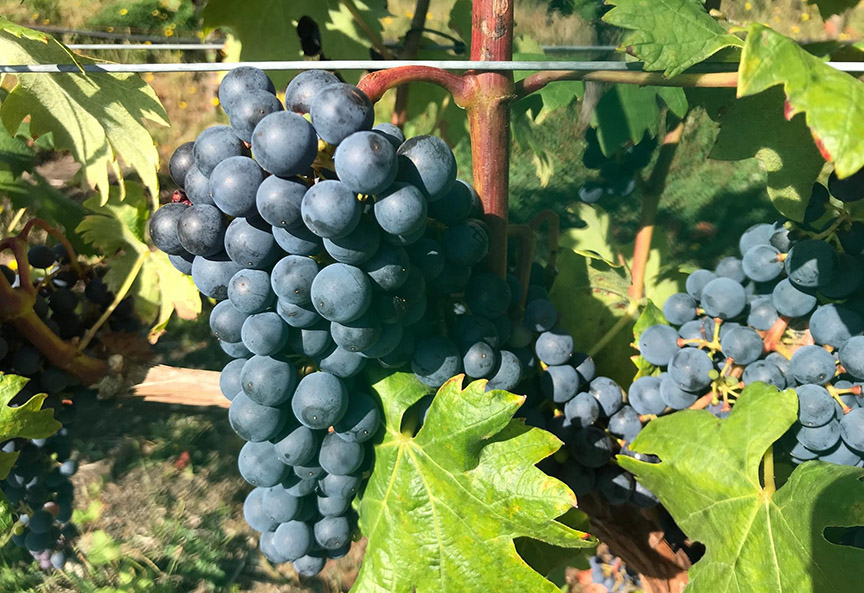
Hybrid Red Winemaking
Early on, I watched multiple winemakers transition to hybrid winemaking using their traditional Cabernet Sauvignon or Pinot Noir tool kits with less than stellar results. Again, with the caveat that there is no “one size fits all” approach, this article includes the techniques that have worked for me for a range of red hybrids.
Harvest
I find that red hybrid wines are less forgiving of compromised fruit, so extra care should be used to eliminate mildew- or Botrytis-impacted fruit, bunches damaged by birds, hard green berries, and MOG (matter other than grapes). Stem inclusion is not recommended, and leaves and other plant matter should be eliminated, as they will increase undesirable vegetal flavors in the finished wine.
Picking dates and hang time will vary by variety, and you will need to adapt. For example, one of the hybrids we grow, Cabernet Libre, only gets to 20 °Brix no matter how long you allow it to hang in the vineyard or how hot the growing season was. It is physiologically incapable of getting higher sugar levels. It tends to hit 20 °Brix about 10 days to two weeks prior to our next earliest red variety, Pinot Noir. However, we do not pick it until we pick the Pinot Noir. By letting it hang, we see acid levels drop, reduced pyrazine character, improved fruit flavors, and tannin development. What we don’t see in that 10 day-to-two week period is increased sugar levels, so some chaptalization is required. In contrast, our Marechal Foch is ready to pick as soon as it hits 23–24 °Brix — the phenolic and sugar ripeness coincide, and the acid levels are in the desired zone simultaneously. Like all grapes, hybrid varieties have their quirks. The more harvests you work with them the better, and you understand what works and what doesn’t for the style of wine you are trying to make.
Maceration
Two common traits across many red hybrids are a high anthocyanin color compound content and a lower tannin level in the finished wine compared to vinifera grapes. In some of the literature, it appears that red hybrids have comparable tannin levels in the grape skins to vinifera, however it seems that these either aren’t released into the wine during fermentation, bind with high protein levels in some hybrids, or are unstable and “fall out.”
The traditional approach to vinifera red winemaking would be to either use more extractive enzymes or to use extended maceration techniques (either pre- or post-fermentation). In my experience, when applying these techniques to hybrids, they exacerbate undesirable flavor notes due to increased seed extraction.
My maceration recommendation for red hybrids is to crush into insulated bins, inoculate with yeast right away, and quickly get the must up to a fermentation temperature of 85–95 °F (30–35 °C). Because red hybrids tend to have high levels of color compounds, long skin contact times are not needed to get deep, rich color. With varieties such as Frontenac, Marechal Foch, and Cabernet Libre, I press with 5–8 °Brix of sugar remaining and finish fermentation to dryness in the tank. The rationale behind this is to press the wine away from the skins before the solvent effect of increasing alcohol levels extracts undesirable flavor compounds from the seeds. This technique is also helpful when working with “foxy” native varieties or underripe red grapes in general. This process could be characterized as “ferment hot and fast, then press early.” The focus is to reduce vegetal notes and hybrid seed flavors as hybrid seeds often carry undesirable flavor compounds due to their indigenous parents, and to produce wines that will appeal to a broad audience.
I have tried the delestage, or “rack and return,” method to get the seeds out of the fermenting must, but have found better results with this short maceration approach as it arrests extraction of both the seed and skin compounds in the wine.
I have also found that products designed for underripe fruit work well with this hot and short maceration approach. Lallemand’s Red Style, which is a combined enzyme and inactivated yeast, is a product I have used with this short maceration technique with great results. It releases desirable fruit character, helps stabilize the tannins, and doesn’t extract undesirable seed compounds.
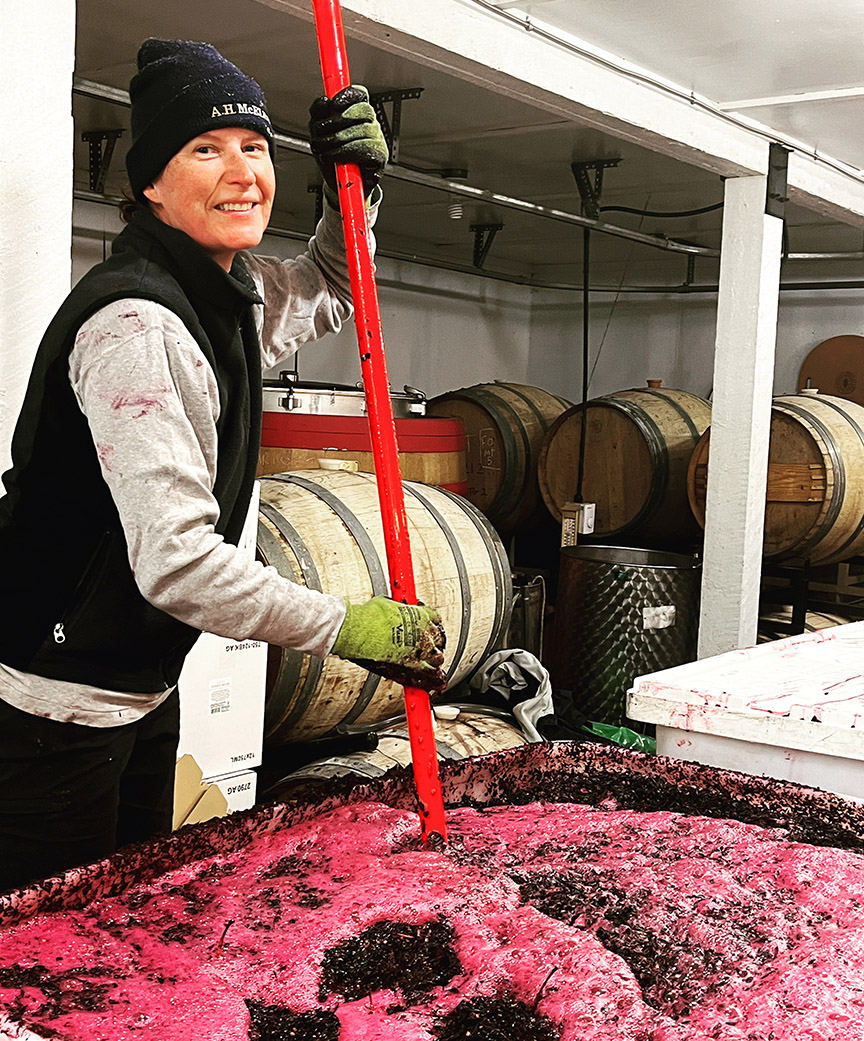
Tannins
As noted earlier, most red hybrid wines have lower tannin levels than red vinifera wines. Depending on your preference, this may or may not be desirable. On some varieties, such as Marechal Foch, this can be a positive. In our winery, Marechal Foch sells very well to people looking for something more quaffable and easy drinking. For those looking for something with a more traditional tannin profile and increased aging ability, supplemental tannins are an effective tool.
One option is the use of untoasted oak chips or powder during primary fermentation, which has the benefit of promoting fruit flavors and suppressing vegetal or “foxy” character. Untoasted oak chips, especially American, are helpful in this regard. I have used 1–4 g/L successfully; the higher end of the range being applied if green seeds or less ripeness are present and for varieties known to be quite low
in tannin.
There is also a range of fermentation-stage tannin products that can be used that may be extracted from grape skins, oak, or exotic woods. I’ve found that adding these products at the highest end of the manufacturer’s recommended range early in primary fermentation can assist with color stability and tannic mouthfeel of the resulting wines.
With my hybrid reds, after many trials, I use both untoasted oak powder and fermentation-stage tannins during primary fermentation, both added at crush. These early additions promote later tannin retention because they mitigate the impact of proteins in the must (so called sacrificial tannins) and bind with natural tannins in the must to form stable tannin structures that will be retained in the finished wine as it ages.
If you find as the wine ages there is still a need for more “tannic grip,” cellaring-stage tannins are available. I recommend conducting bench trials and then adding half of what you think you need to start with. Wait a month and then reassess any additional cellaring tannin additions. It is easier to make a second addition than to come back from an over-addition.
Co-fermentation
I have found good results when co-fermenting red hybrids with other varieties in the same vessel. When working with Frontenac, I found that co-fermenting 5% Petite Sirah or Cabernet Sauvignon “filled the hole” in the wine’s tannic profile and contributed to enhanced mouthfeel.
I have fermented Cabernet Foch with the skins of Viognier at about 3% of the volume to boost fruit notes and improve color stability. I have also had success fermenting 5% Blattner White (an unnamed hybrid) in our Cabernet Libre. The technique and results are similar to co-fermentations of Syrah and Viognier that are popular in the Rhône region of France and Australia.
I believe this remains an area worth further exploration.
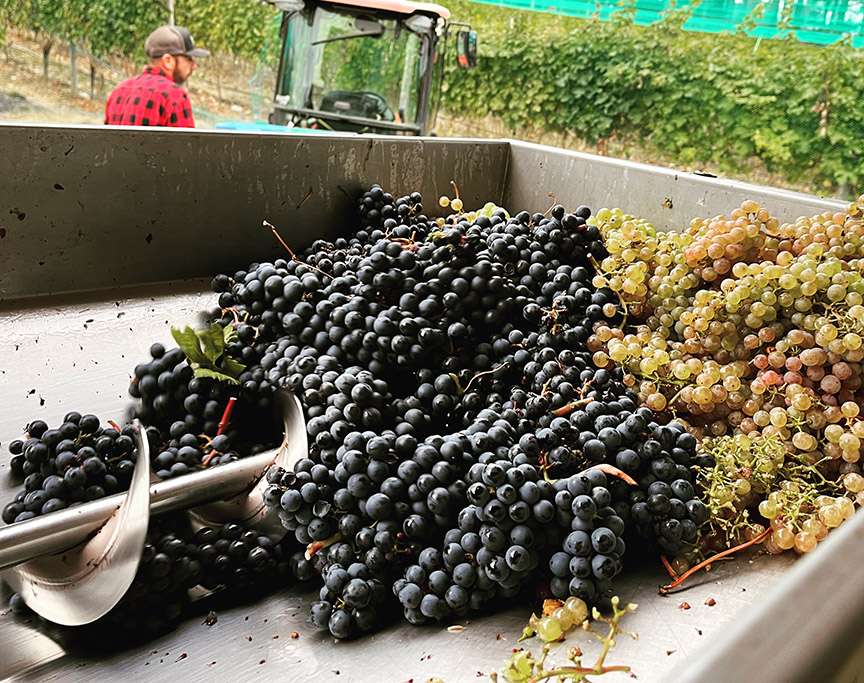
Yeast Selection
With hundreds of yeast strains available, winemakers can select yeasts to suit the challenges of the particular variety they are working with. Here are some of my favorites and their application in a hybrid context:
Maurivin B:
This is a malic acid-consuming yeast, which is handy if working with higher acid musts. It is the most aggressive malic metabolizer commonly available and can reduce malic acid by up to 55% during primary fermentation.
Renaissance Andante:
Also a malic-consuming yeast for red wines, Andante can reduce malic by 25–30%. This strain is also a “no-H2S” producing yeast, so it’s helpful if working with grapes with low natural nitrogen levels or a tendency to produce reductive notes. Some hybrids have an increased risk of developing reductive notes and this yeast has proven to be a good tool to reduce this risk.
Lalvin ICV GRE:
This yeast is good for promoting fruit character and reducing vegetal notes. I’ve had good results when fermenting half the batch with one of the previously mentioned yeasts and the other half with GRE and blending the two as they are put into barrel.
These three yeasts also all do well at the elevated fermentation temperatures and short maceration times I recommend for red hybrids.
Malolactic Fermentation
When selecting a malolactic (ML) bacteria to use with hybrid grapes, you may want to use one that is effective at low pH levels and produces little or no diacetyl. My go-to ML bacteria for hybrids is Lalvin MBR 31. With elevated malic acid levels commonly present in hybrids, you do not want the high butter flavors an ML bacteria suitable for Chardonnay, like
Enoferm BetaTM, can produce.
Blending
On the flavor arc, many red hybrids have a beautiful bold attack and a nice long finish, however, the middle of the wine can be a bit lost and soupy. I put this down to the lower tannin levels. Blending in 5–20% of a red vinifera can give increased mouthfeel and mid-palate.
Concentrates
As a home winemaker, I made many successful batches using red grape concentrate (1–4% of total must) sourced from wine kits, added to the must before fermentation. This enhanced tannin profile masked “green” notes and enhanced color stability. This may be used in conjunction with or instead of fermentation stage tannin additions discussed earlier. Concentrate will increase the sugar level just slightly at this small addition rate so sugar must still be added if you need to chaptalize more
than about 1 °Brix.
Barrel aging
As with vinifera, hybrid reds greatly benefit from a barrel-aging program of at least 12 months. While preferences vary, American oak’s vanilla-forward character is a good match for many red hybrids. I like to use around 20% new oak for fruit-driven varieties like Marechal Foch and up to 100% new American oak on varieties like Frontenac Noir. Some experimentation is needed — I make a blend that’s 70% Cabernet Foch, 15% Merlot, and 15% Cabernet Libre that really shines with 50% new French oak.
In a home winemaking context, oak adjuncts such as cubes, staves, and chips work well to achieve the desired oak profile.
Conclusion
Making wine from red hybrid grapes is a relatively new area in the field of winemaking. This article is not intended to be a definitive text on the subject, but it does include the techniques I have found to work best in both my own home winemaking and current commercial winemaking since making my first hybrid red wines in a Montreal garage in 2003. It is my hope that you will continue to experiment and refine your own winemaking techniques working with these wonderful modern grape varieties.



